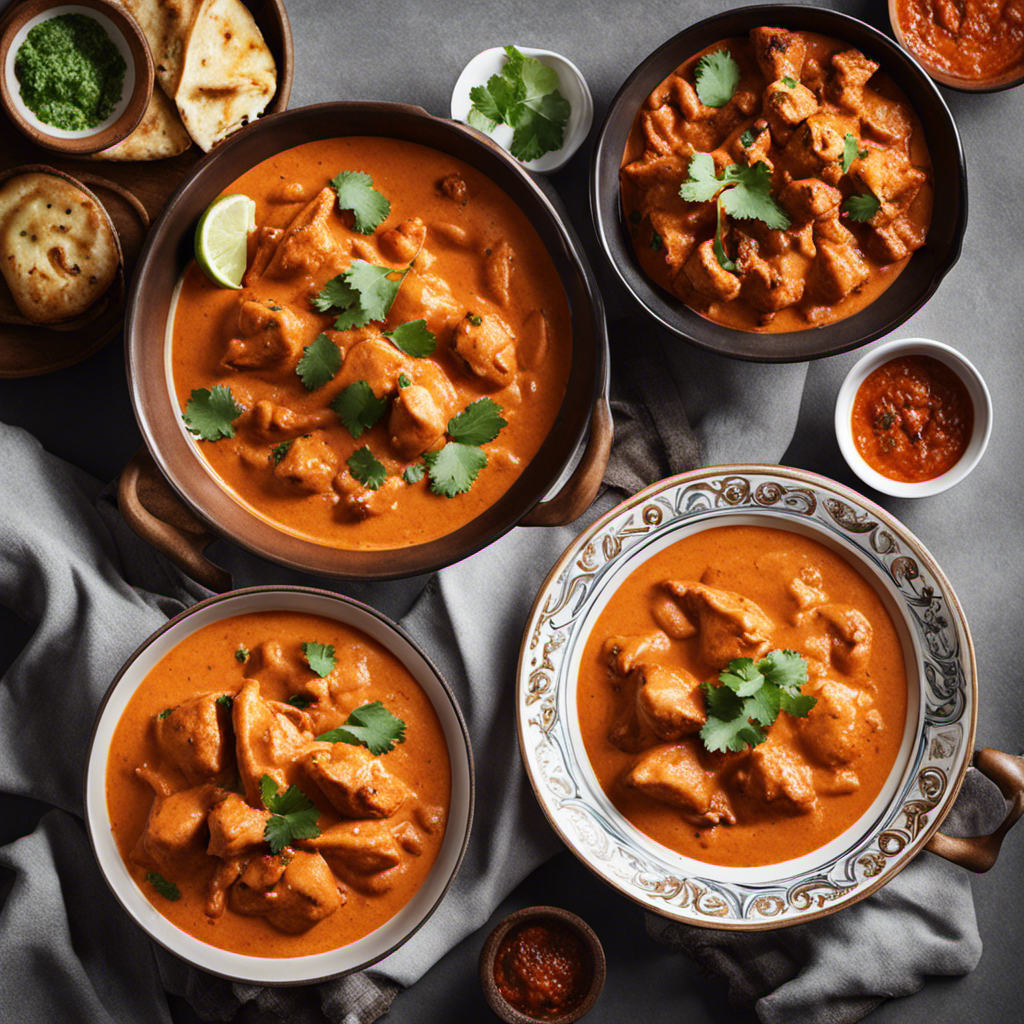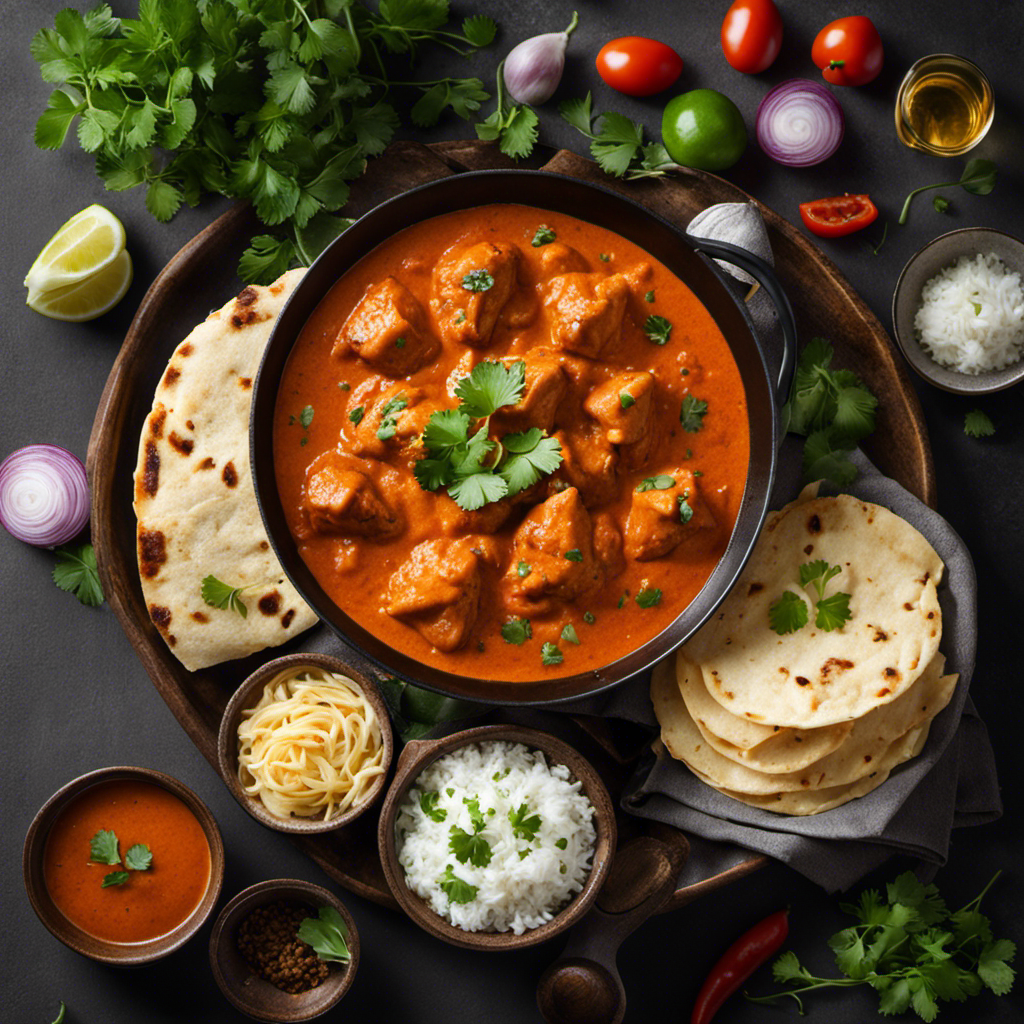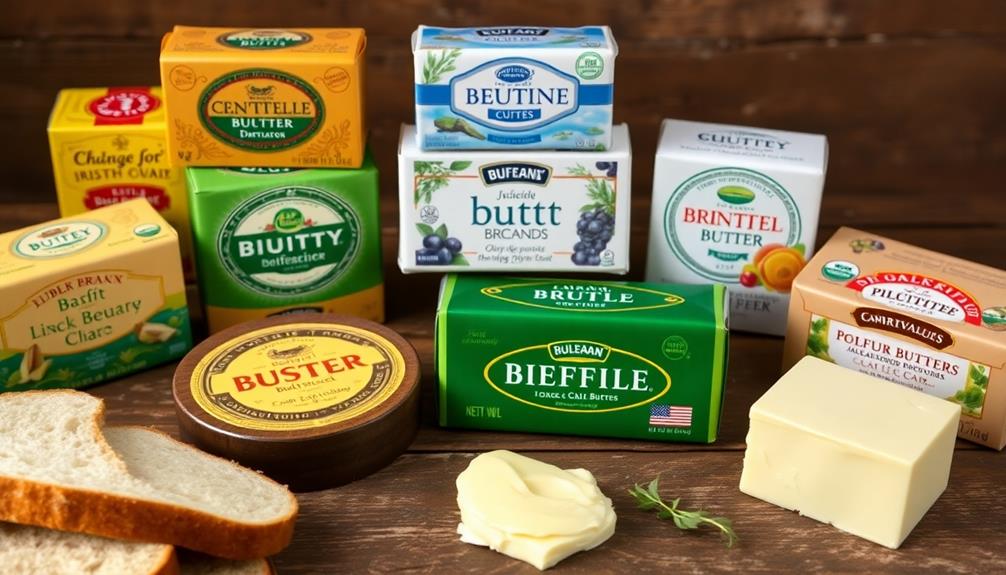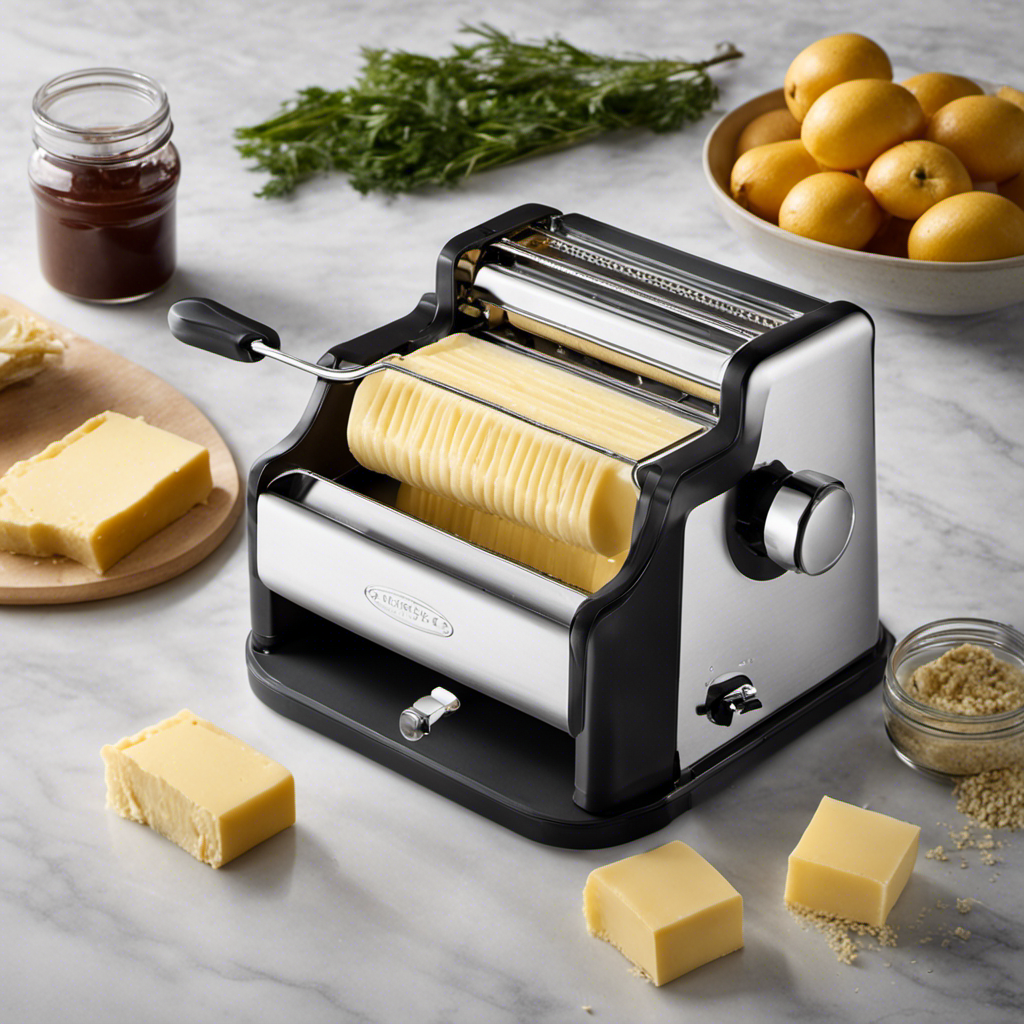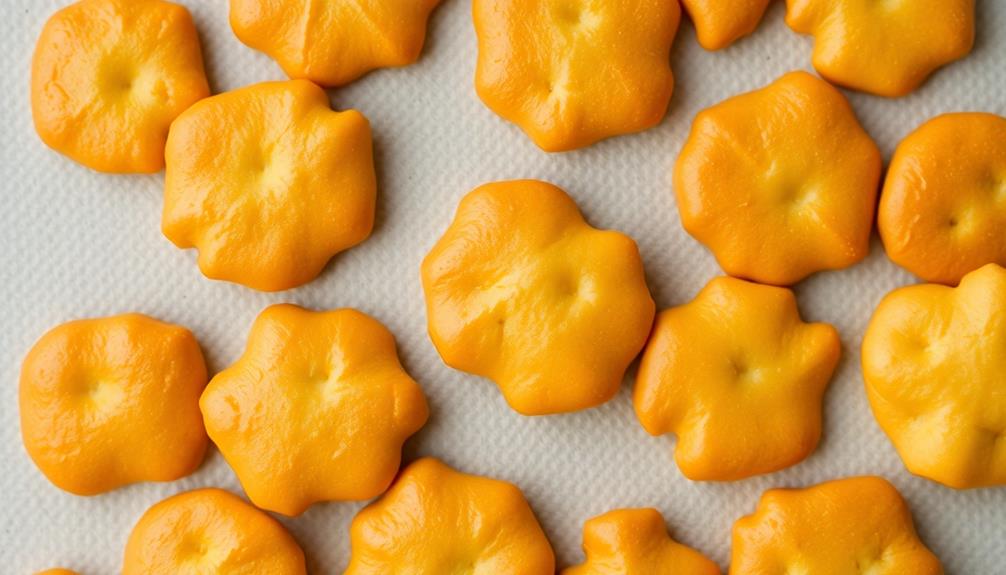As an enthusiast of Indian food, I frequently ponder over which meal is the more nutritious option: butter chicken or tikka masala. In this piece, I will examine the nutritional value, inspect the components, and assess the calorie and fat content present in each of these dishes.
Additionally, I’ll be examining the sodium levels and assessing the potential health benefits of each. By the end, you’ll have the information you need to make a healthier choice without sacrificing flavor.
Let’s dive in and uncover the truth!
Key Takeaways
- Ingredient quality, such as organic chicken and fresh spices, affects the nutritional value of both butter chicken and tikka masala.
- Butter chicken is richer in calories and fat due to the use of butter, cream, and ghee, while tikka masala can be lower in fat with a tomato-based sauce and lean protein.
- Both dishes are good sources of protein, but grilling or baking the chicken can reduce the fat content.
- Sodium content is an important factor to consider, as excessive intake can increase the risk of heart disease and stroke. Butter chicken may have higher sodium levels due to added salt and spices, while tikka masala’s sodium content can be influenced by yogurt and spices.
Nutritional Comparison
Butter chicken and tikka masala have similar nutritional profiles. Both dishes are made with chicken and a creamy tomato-based sauce, which gives them their rich and flavorful taste. However, the nutritional value of these dishes can vary depending on the ingredient quality and cooking methods used.
When it comes to ingredient quality, opting for organic chicken and fresh spices can enhance the overall nutritional value of both butter chicken and tikka masala. Organic chicken is typically raised without antibiotics and hormones, making it a healthier choice. Fresh spices, on the other hand, contain more antioxidants and beneficial compounds compared to pre-packaged spice blends.
Cooking methods also play a crucial role in the nutritional content of these dishes. Grilling or baking the chicken, instead of frying, can reduce the amount of unhealthy saturated fats. Additionally, using less cream or opting for healthier alternatives like Greek yogurt can lower the calorie and fat content of the sauces.
Ingredient Analysis
While it’s widely known that the two dishes differ in terms of ingredients, it’s important to consider their overall nutritional value. When comparing the nutritional value of butter chicken and tikka masala, several factors come into play. Here are some key points to keep in mind:
-
Butter chicken tends to be richer in calories and fat due to the use of butter, cream, and ghee.
-
Tikka masala, on the other hand, can be lower in fat if prepared with a tomato-based sauce and lean protein.
-
Both dishes can be good sources of protein, especially if made with chicken or paneer.
-
The cooking techniques used can greatly impact the nutritional value. Grilling or baking the protein instead of frying can reduce fat content.
Considering these factors, it’s important to make mindful choices when enjoying these flavorful Indian dishes, focusing on portion sizes and incorporating other nutritious components into the meal.
Calorie Breakdown
When it comes to choosing between butter chicken and tikka masala, one important factor to consider is the calorie content.
In this discussion, we will compare the calorie breakdown of these two popular Indian dishes and explore which one might be a healthier option.
Butter Chicken Vs. Tikka
If you’re trying to decide between butter chicken and tikka masala, you might want to consider their differences in terms of flavor and spice level. Here are some key points to help you make your decision:
-
Flavor comparison:
-
Butter chicken: This dish has a rich and creamy tomato-based sauce with a hint of sweetness. The flavors are well-balanced and comforting.
-
Tikka masala: This dish is known for its robust and tangy flavors. It has a tomato-based sauce with a blend of aromatic spices that give it a bold and vibrant taste.
-
Spice level:
-
Butter chicken: It tends to be milder in terms of spice level, making it a suitable choice for those who prefer a less spicy option.
-
Tikka masala: This dish can be spicier, but the heat can be adjusted according to personal preference.
Both butter chicken and tikka masala hold cultural significance, with butter chicken being a popular dish in the Punjabi cuisine of Northern India, and tikka masala having its roots in British Indian cuisine. Ultimately, the choice between the two comes down to personal preference for flavor and spice level.
Calorie Comparison
The calorie content differs between butter chicken and tikka masala, so it’s important to consider this when making your choice.
Butter chicken typically contains more calories than tikka masala. This is because butter chicken is made with a rich and creamy gravy that includes butter and heavy cream. On the other hand, tikka masala is made with a tomato-based sauce that is typically lower in calories.
When it comes to fat content, butter chicken also tends to have more fat due to the use of butter and cream. However, both dishes can be high in fat overall.
In terms of nutritional value, both butter chicken and tikka masala provide a good amount of protein from the chicken. However, it’s important to note that the high fat content in these dishes may not make them the healthiest options.
Healthier Option
To make a healthier choice, consider opting for a dish with a tomato-based sauce and lean protein. Tomato-based sauces are generally lower in calories and saturated fats compared to cream-based sauces, making them a better option for those looking to watch their weight or improve their overall health.
Additionally, lean proteins like chicken or tofu provide essential nutrients without excessive amounts of fat. When it comes to nutritional value, tomato-based sauces are a great source of vitamins A and C, as well as lycopene, a powerful antioxidant.
Cooking methods also play a role in the healthiness of a dish. Grilling or baking the protein instead of frying it can further reduce the calorie and fat content.
Fat Content Examination
Comparing the fat content, butter chicken has a higher level of fat than tikka masala. When evaluating the nutritional value of these two popular Indian dishes, it is important to consider the fat content.
Butter chicken is made with a rich and creamy sauce that typically contains a significant amount of butter, cream, and sometimes even ghee. On the other hand, tikka masala usually has a tomato-based sauce that is lighter and lower in fat.
The higher fat content in butter chicken can contribute to a higher calorie count as well. However, it is important to note that both dishes can be enjoyed in moderation as part of a balanced diet.
Transitioning into the subsequent section about sodium levels evaluation, let’s explore how these dishes fare in terms of their sodium content.
Sodium Levels Evaluation
When it comes to evaluating the sodium content in food, there are important factors to consider.
Comparing the sodium levels in different dishes can help us make informed choices about our diet.
Additionally, understanding the health implications of sodium can guide us towards a balanced approach to our overall well-being.
Comparing Sodium Content
You should check the sodium content of both butter chicken and tikka masala to determine which one is healthier. Sodium intake recommendations suggest that adults should consume no more than 2,300 milligrams of sodium per day. Excessive sodium intake can have a negative impact on blood pressure, increasing the risk of heart disease and stroke.
When comparing the sodium content of butter chicken and tikka masala, here are some key points to consider:
- Butter chicken typically contains a creamy tomato-based sauce, which may have a higher sodium content due to added salt and spices.
- Tikka masala often includes yogurt and spices, which can contribute to its sodium content.
- Both dishes may vary in sodium levels depending on the recipe and cooking method used.
It is important to read nutrition labels or ask the restaurant for information on sodium content to make an informed decision about your meal choice.
Health Implications of Sodium
Excessive sodium intake can lead to negative health implications such as increased blood pressure, which can increase the risk of heart disease and stroke. It is important to be mindful of our sodium intake because the effects of high sodium intake can be detrimental to our health.
According to the American Heart Association, the recommended daily sodium intake for adults is no more than 2,300 milligrams, and ideally, no more than 1,500 milligrams for individuals with high blood pressure or at risk of developing it.
Consuming too much sodium can cause fluid retention, which puts strain on the heart and blood vessels, leading to increased blood pressure. This, in turn, can increase the risk of heart disease and stroke.
Considering these health implications, it is crucial to assess the overall benefits and drawbacks of our dietary choices.
Health Benefits Assessment
To assess the health benefits of butter chicken and tikka masala, it’s important to consider the ingredients used in both dishes. Here are some key points to keep in mind:
-
Nutritional Value: Both butter chicken and tikka masala are rich in protein due to the chicken used in these dishes. They also contain various spices and herbs that provide essential vitamins and minerals.
-
Impact on Digestion: The spices used in Indian cuisine, such as ginger, garlic, and turmeric, have been known to aid digestion. However, the high fat content in butter chicken can slow down digestion and may not be suitable for individuals with digestive issues.
-
Balance is key: While both dishes have their nutritional benefits, it’s essential to consume them in moderation. Opting for healthier cooking methods and portion control can help maintain a balanced diet.
Making a Healthier Choice
Now that we have assessed the health benefits of butter chicken and tikka masala, it’s time to make a healthier choice. Both dishes can be enjoyed in moderation, but if you’re looking for a healthier option, tikka masala may be the way to go.
While butter chicken is rich in flavor and creamy due to the addition of butter and cream, tikka masala can be made with a base of tomato, yogurt, and spices. This means that tikka masala has a lower fat content and fewer calories compared to butter chicken.
To further illustrate the nutritional benefits, let’s compare the two dishes in terms of their calorie and fat content:
| Nutritional Information | Butter Chicken | Tikka Masala |
|---|---|---|
| Calories per serving | 400 | 300 |
| Fat per serving | 20g | 10g |
It’s important to note that taste preference also plays a significant role in making a healthier choice. While tikka masala may be a healthier option, some people may prefer the rich and creamy taste of butter chicken. Ultimately, it’s about finding a balance between taste and nutrition.
Frequently Asked Questions
Can I Make a Vegetarian Version of Butter Chicken or Tikka Masala?
Yes, it is possible to make a vegetarian version of butter chicken or tikka masala. By using plant-based alternatives like tofu or paneer, and substituting dairy products with vegan options, you can enjoy these dishes in a meatless and healthier way.
What Are the Differences in Flavor Between Butter Chicken and Tikka Masala?
When comparing the flavors of butter chicken and tikka masala, it’s important to note that both dishes have distinct tastes. Butter chicken is rich and creamy, while tikka masala is spicier and tangier.
Is It Possible to Make a Gluten-Free Version of Butter Chicken or Tikka Masala?
I’ve looked into making gluten-free versions of butter chicken and tikka masala. There are several substitutes you can use, like coconut milk or yogurt, to replace the gluten-containing ingredients. Gluten can have negative health effects for some individuals.
Can I Substitute the Traditional Dairy-Based Ingredients in These Dishes With Plant-Based Alternatives?
When it comes to substituting dairy in Indian dishes, it is possible to use plant-based alternatives. Not only can this cater to dietary restrictions, but it also allows for a comparison of taste between plant-based and dairy-based options.
Are There Any Traditional Spices or Herbs Used in Butter Chicken or Tikka Masala That Have Specific Health Benefits?
There are several traditional spices and herbs used in Indian cuisine, like turmeric and ginger, that have specific health benefits. Additionally, the impact of cooking methods can affect the overall healthiness of dishes.
Conclusion
After conducting a thorough analysis of the nutritional content and health benefits of butter chicken and tikka masala, it is clear that tikka masala is the healthier option.
Not only does it have lower calorie and fat content, but it also contains higher levels of essential nutrients such as protein and fiber.
One interesting statistic to note is that tikka masala has 30% less fat than butter chicken, which can have a significant impact on overall health and weight management.
By choosing tikka masala, individuals can enjoy a delicious meal while prioritizing their health.
